The Babylonian Captivity of Portuguese India
The Case of Damaõ
Based on A Queda da India Portuguesa ("The Fall of Portuguese India") by Colonel Carlos Alexandre de Morais, reports from the Times of India, Bombay, of December 30, 1961, and on anecdotes recounted by surviving Damaõense patriots and defenders.
Copyright Terms & Conditions | Home | Michaelinum.
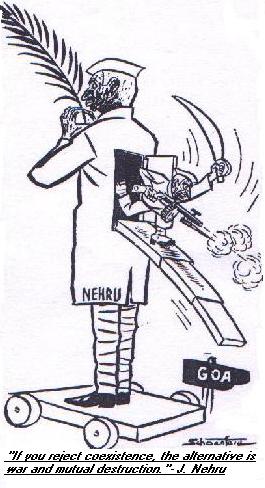 After the invasion and occupation of Dadra & Nagar-Aveli by terrorists paid and organized by the Indian Union in 1954, the remainder of the District of Damaõ, situate on the coast of the Gulf of Cambay (also called "Khambatta"), measured around 50 k.m.2 and had approximately 22,300 inhabitants. It is bound by the Rio de Coileque in the north, the Rio de Calem in the south, and bisected by the Rio de Sandalcalo, (which the Indian Union calls the Damanganga River), in the center. Two forts face each other across this river: the Fort of Damaõ Grande and the Fort of Saõ Jerónimo in Damaõ Pequeno. In the year prior to the Indian invasion of Damaõ in December 1961, 106 ships had called, discharging 84,572 tonnes of cargo. The Airport in Damaõ Pequeno had two runways: one 2
k.m. long and the other 1 k.m. long.
After the invasion and occupation of Dadra & Nagar-Aveli by terrorists paid and organized by the Indian Union in 1954, the remainder of the District of Damaõ, situate on the coast of the Gulf of Cambay (also called "Khambatta"), measured around 50 k.m.2 and had approximately 22,300 inhabitants. It is bound by the Rio de Coileque in the north, the Rio de Calem in the south, and bisected by the Rio de Sandalcalo, (which the Indian Union calls the Damanganga River), in the center. Two forts face each other across this river: the Fort of Damaõ Grande and the Fort of Saõ Jerónimo in Damaõ Pequeno. In the year prior to the Indian invasion of Damaõ in December 1961, 106 ships had called, discharging 84,572 tonnes of cargo. The Airport in Damaõ Pequeno had two runways: one 2
k.m. long and the other 1 k.m. long. The Defenders of Damaõ were organised into the Group (or Agrupamento) Dom Constantino de Bragança, comprising:
- Company of Infantry No. 11
- Company of Infantry No. 12
- Battery of Artillery No. 3
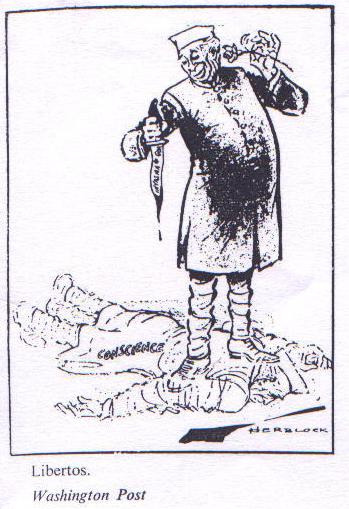 These totaled around 700 persons and were reinforced by the Police and Custom Guards of 200 and 33 persons respectively. The Damaõense Police manned 13 frontier posts. On the Indian side, opposing the defenders were 4000 men consisting of personnel from the regular military and from the paramilitary Special Reserve Police, who were transported to the environs of Damaõ, disembarked at the Vapi and Sanjan railway stations and placed in siege positions around Damaõ.
These totaled around 700 persons and were reinforced by the Police and Custom Guards of 200 and 33 persons respectively. The Damaõense Police manned 13 frontier posts. On the Indian side, opposing the defenders were 4000 men consisting of personnel from the regular military and from the paramilitary Special Reserve Police, who were transported to the environs of Damaõ, disembarked at the Vapi and Sanjan railway stations and placed in siege positions around Damaõ. Around 2.00 a.m. in the morning of December 18 1961, Indian troops made the first crossing into Damaõense territory near the Post of Benselor in the direction of the airport, unnoticed by the Damaõense troops. Around 4.00 a.m., the Indian Army, located along the frontiers of Damaõ, simultaneously opened fire on the Damaõense positions, and rapidly advanced into Damaõ. Around 4.30 a.m. the Indians commenced bombarding Damaõ Grande, planned to hit the Palace of the Governor, and the military and telegraph installations. By 4.00 a.m. radio contact with Goa had ceased as the antennae had already been damaged. At 6.30 a.m. the Governor, Major Antonio Jose da Costa Pinto, left the Governor's Palace for the nearby hospital to see to the injured. At 7.30 a.m. two Indian jets flew just over both forts and strafed them with missiles, bombs and machine gun fire. At 10.00 a.m., Major Costa Pinto crossed the Rio Sandalcalo to inspect the defense frontlines at Damaõ Pequeno. At 11.00 a.m. the third bombardment of Damaõ was launched by the Indians principally in front of the line of combat and over the Fort of Sao Jerónimo. While the Indian army was trying to advance against very effective resistance by the Damaõense, the fourth aerial bombardment was launched by the Indians at 2.00 p.m. on the Fort of Sao Jeronimo, the defensive positions in Damaõ Pequeno and on other spots of resistance. By 4.30 p.m. the fifth bombardment began, followed by the sixth at 5.30 p.m.. The last bombardment by the Indians was so heavy that by 11.00 p.m. some demoralized military personnel in Damaõ Grande hoisted white flags and surrendered.
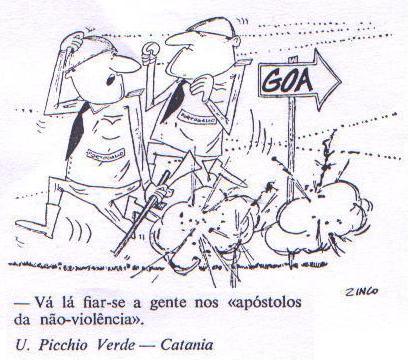 At 7.00 a.m. on December 19, the seventh aerial bombardment by the Indians began. Thereafter, Major Costa Pinto reviewed the situation and decided to negotiate surrender with the invading enemy and at 9.00 a.m., Lieutenant S.J.S. Bhonsale accepted the surrender, by which time Major Costa Pinto had already been injured.
At 7.00 a.m. on December 19, the seventh aerial bombardment by the Indians began. Thereafter, Major Costa Pinto reviewed the situation and decided to negotiate surrender with the invading enemy and at 9.00 a.m., Lieutenant S.J.S. Bhonsale accepted the surrender, by which time Major Costa Pinto had already been injured. An interesting incident took place at the time of the surrender. Major General O.P. Dunn who had planned the logistics of the Indian invasion of Portuguese India joined Lt. Col. Bhonsale while discussing the terms of the surrender, the loyal dog of Major Costa Pinto who had been with his master throughout saw Dunn's dangling hand and bit it.
Tribute must be paid to members of the Damaõ Police who defended their homeland to the bitter end. In particular, one Saturnino Colaço, ensconced in a trench near the airport, kept shooting down the Indian paratroopers as they dropped over the airport, and executed 15 of them.
The Goan death toll comprised seven persons. Most of the injured Goans were taken from treatment to Bombay, though Major Costa Pinto refused to be moved to Bombay and was treated in Damaõ. Major Costa Pinto was promoted for distinction and awarded a medal for military valor.
"Arms from Western Allies Seized In Daman"
"LT.-COL. BHONSLE HAILS OUR JAWANS' BRAVERY"
In the Times of India, Bombay Edition, December 30, 1961."The Times of India" News Service. Surat, December 29.
The arms and ammunitions seized in Daman from the Portuguese bear American, British, French, German and NATO markings, according to Lt.-Col. J.S. Bhonsle of the First Battalion of the Maratha Light Infantry who successfully led "Operation Daman".
He said the Portuguese with huge dumps of arms and ammunition seemed to have been prepared to fight for at least one month in Daman. All strategic points were mined and each post had an average of three machine-guns. These posts had also barbed wire fencing.
Col. Bhonsle, who met the press yesterday for the first time after the action at Daman, conducted a group of journalist around the battle-damaged area. Assisted by Major M. Mutalik, Company Commander, Col. Bhonsle explained the major military actions in Daman.
"FIVE INDIANS KILLED"
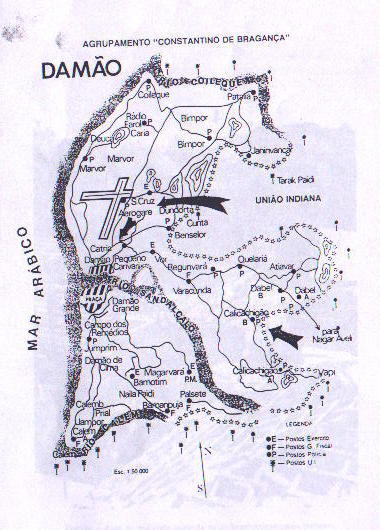 He gave three reasons for the Portuguese putting up the stiffest resistance in Daman. First, Major Antonio Pinto, the Governor of Daman, who was in overall command of the military operations, was an ultra-loyal orthodox military man who had no idea of the Indian strength; secondly, he did not believe that Panjim would surrender so soon and, thirdly, his only means of communication with Goa—the wireless station—was smashed by Indian air action.
He gave three reasons for the Portuguese putting up the stiffest resistance in Daman. First, Major Antonio Pinto, the Governor of Daman, who was in overall command of the military operations, was an ultra-loyal orthodox military man who had no idea of the Indian strength; secondly, he did not believe that Panjim would surrender so soon and, thirdly, his only means of communication with Goa—the wireless station—was smashed by Indian air action. He said that four Indian soldiers and a Special Reserve Policeman were killed in action in Damon on the Indian side. Fourteen soldiers and eight S.R.P. men were also wounded.
On the Portuguese side, four local policemen and a white soldier were killed. Twelve Portuguese soldiers and the Governor himself were wounded.
Col. Bhonsle said that in all, 778 Portuguese military and police personnel, all armed, were "arrested" (sic!). They included an African and 23 Portuguese officers, 540 white soldiers, eight Portuguese police sergeants and 206 local policemen. All these had been detained except the local policemen who had been handed over to the Civil Administrator.
Those killed in action on the Indian side were Subedar Rajaram Chauhan, Naik Gulab Pardeshi, Sepoy Hanumant Kadam, Sepoy Rambhau Vaidya and S.R.P. man Rajaram.
"GOVERNOR PROGRESSING"
The Portuguese Governor, who was wounded in his right thigh by a bullet, is confined to bed in hospital. He is progressing and is reconciling himself to the new situation. "He has learned to smile," Col. Bhonsle said.He paid glowing tributes to the jawans who fought bravely although 90% of them had no experience in fighting a war.
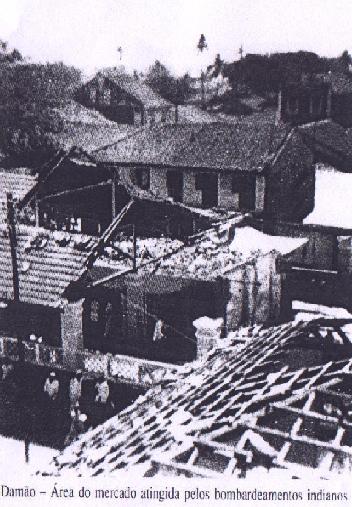 He said that Indian Army men deployed on the Daman front did not exceed 900. The Portuguese had created 23 "pill-box" posts with huge stores of arms and ammunition. The Indian soldiers were in good spirits even though they were on active duty for 48 hours without food.
He said that Indian Army men deployed on the Daman front did not exceed 900. The Portuguese had created 23 "pill-box" posts with huge stores of arms and ammunition. The Indian soldiers were in good spirits even though they were on active duty for 48 hours without food. He added: "The steadiness of our boys in the face of tremendous fire from over 30 machine guns trained at them at a time was simply wonderful and far that exhibited on the Portuguese side. Any country could be proud of such boys."
He said that they had rightly earned praise from Lt.-Gen. Chaudhari who was in overall command of the Goa operation.
He said that all possible care was taken to ensure that all places, except military targets were avoided and not hit, but the Portuguese had lodged their army in the heart of the town's residential area.
Capt. Bhonsle said that all the arrested (sic!) Portuguese soldiers were well cared for. The Portuguese had dumped all sorts of arms and ammunition in wells and these arms were being removed and stored.
The four companies which attacked the Daman fort were commanded by Maj. M.V. Mutalik, Maj. G.S. Sivakar, Maj. G.R. Shinde and Capt. Sahaji Mohite under the overall command of Col. Bhonsle. The artillery was commanded by Maj. Jagjitsingh while Lt. Gill was in charge of air operations.
"3,300 Portuguese Lay Down Arms"
"5,000 GOANS ARE ABSCONDING"
NEW DELHI, December 29: Altogether 3,296 men of the Portuguese armed forces in Goa, Daman and Diu—as many as 3,240 among them whites, including 236 officers—laid down arms during the recent operations, according to the latest official figures received here. They were interned.There was only one African officer among the Portuguese forces. The bulk of Goan soldiers and officers disappeared and their number is estimated at about 5,000. Among the Goans who surrendered were two officers and 53 other ranks.
It is stated here that nearly 2,000 Goan policemen also deserted the Portuguese and ran away as the colonial administration cracked up.
Indian troops have already started withdrawing, and it is expected that the bulk of the force will come back within the next few weeks.
Notes:
- Unlike in Goa, where the Governor, Vassalo Silva was a secret Communist and traitor, and who contrived to undermine the resistance and to ensure the near uncontested capitulation of Goa, Damao, under the leadership of the stalwart patriot Governor Costa fought on against vastly superior arms and numbers.
- Neither did Goa nor Damao or Dio have any military aircraft to defend itself.
- The fiercest resistance was always that put up by the naval units.
- Indian malice is proven beyond the least shadow of doubt by its segration of Goan troops into "Whites" and natives, betraying its anxiety to wedge them apart; by its use of the words "arrested", to describe surrendering Goan troops, and by the use of the word "absconding" to describe the non-existent groups of purely Goan troops that India failed to find.
Copyright Terms & Conditions | Home | Michaelinum.